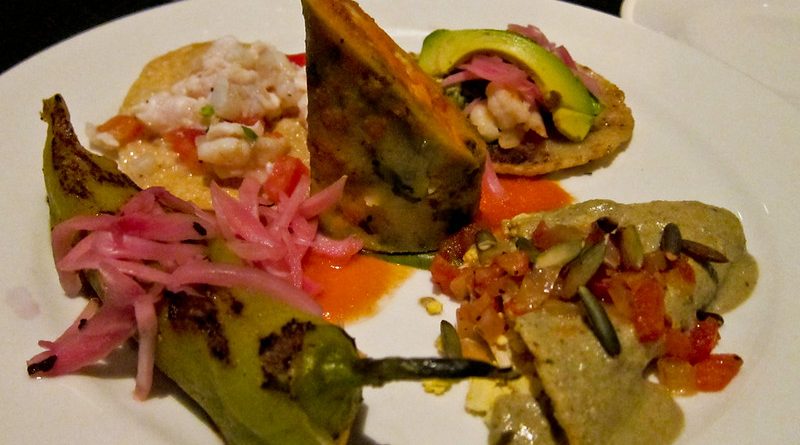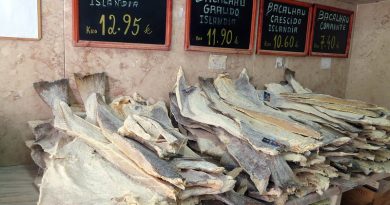Yucatan Cuisine
Yucatán cuisine is distinctive partly because the region was geographically isolated from the rest of Mexico for centuries by mountainous terrain and poor roads. Here are some of the specialities of the region:
Cochinita pibil – the pit-roasted pig marinated in sour Seville orange juice, garlic and that intense-smelling red recado (the ubiquitous herb-and-spice pastes) made from annatto seeds.
Pollo Pibil – Chicken marinated in achiote (annatto), sour orange juice, peppercorns, garlic, cumin, salt, and then wrapped in banana leaves and baked. Not spicy.
Masa – it is often short for masa de maíz, a maize (corn) dough made from freshly prepared hominy. It is used for making corn tortillas, tamales, pupusas, arepas and many other Latin American dishes.
The holy trinity (or “three sisters”) – three main crops are corn, beans and squash, usually augmented by hunting, foraging and gardening.
Huevos en torta – a simple and irresistible egg cake.
Polkanes – the word means “head of the snake,” kind of like Mayan hush puppies, highly recommended when paired with sikli’ p’aak, the salsa of tomatoes and squash seeds.
Polvorones – nut coloured shortbread cookies, which are made with toasted flour and brown butter.
Botanas – little snacks.
Micheladas – a tangy mix of lime juice, Worcestershire sauce, Tabasco and good, dark Yucatán beer.
Papadzules – hard-cooked eggs wrapped in corn tortillas with pumpkin-seed sauce
Sopa de lima – a chicken-tortilla soup that’s flavored with a fragrant local variety of sour lime.
Xnipek – the ubiquitous table sauce of habanero chiles, scallions, citrus juices and cilantro. Xnipek translates to “dog’s nose”—it’s so spicy, one’s nose starts to run after eating it.
Xtabentú – cocktail, an icy margarita-like concoction made with the local anise-and-honey liqueur.
Queso relleno – a stuffed cheese rind that’s a Yucatán delicacy. It is the hollowed-out Edam cheese, the soft part of the cheese, the center, was scooped out by the patrón, the boss. The servants got the rind, which they stuffed and steamed. The process was trim the cheese rind to leave only the thinnest shell, then fill it with a near-black mixture of ground beef, raisins, olives, almonds and spices that have been fried together until nearly caramelized. The stuffed cheese rind, wrapped in cheesecloth and banana leaves, is then steamed until the inside turns molten and runny.
Panuchos & Salbutes – Pre-cooked tortilla with shredded chicken and garnished with lettuce and onion. The difference between panuchos and salbutes is that the first has refried beans inside the tortilla.
Poc Chuc – Tender slices of pork marinated in sour orange juice, grilled, and served with a tangy sauce and pickled onions. Some restaurants offer a chicken version.
Papadzules – Chopped hard-boiled egg rolled up in tortilla and covered with pumpkin seed sauce.
Frijol con Puerco – The Yucatecan version of pork and beans. Chunks of pork cooked with black beans, served with rice, and garnished with radish, cilantro and onion. A regular Monday dish in most Yucatecan homes.
Motul-Style Eggs – A scrumptious breakfast of tortilla, covered with refried beans and a fried egg and then smothered with tomato sauce, peas, chopped ham and shredded cheese. Usually served with some fried banana slices.
Relleno negro – turkey cooked with a paste of charred chiles and vegetables with bits of hard-boiled eggs.
Escabeche blanco – chicken or turkey cooked in a vinegar-based sauce.
Kahlúa – the Arabica coffee-flavored liquor is the Yucatán’s best-known product.
Yucatan Food Influences
The Spanish influences on the cuisine are strong—the conquistadors arrived in the 16th century. The pork and Seville oranges come from Spain. Ports on the Yucatan opened the cuisine up to Spanish influences. Foods included beef, pork, lamb, nuts, fruits, cheese, spices, and sugar cane (by way of the Caribbean) contributed by the conquistadors.
The Mayans, whom the Spanish were never quite able to obliterate, despite their bloody efforts have heavily influenced Yucatan cuisine .The corn, the chocolate and the honey, the venison and wild turkey, squash, cucumbers, chiles and tomatoes are from the Mayans.
Chikindzonot is a village of a couple of thousand people smack in the middle of the peninsula and an hour’s drive from Valladolid, a city of about 50,000. Virtually everyone in the town is Mayan. It’s isolated enough that the farming and the food are largely pre-Columbian in character.
Northern Europeans have left their legacy too, particularly the Dutch: Holland was an active trading partner in the 19th century, when Mérida was the center for the production of henequen, a fiber traditionally used for making rope. Edam cheese came from the Dutch after ports on the Yucatan opened up the cuisine to European influences.
Yucatan Originals
Black Beans – Archaeological digs indicate the black bean originated in southern Mexico and Central America more than 7,000 years ago. Still the favorite in and around the Yucatán, it has spread widely throughout Latin America, the Caribbean, and the U.S.
Chocolate – The Maya’s “food of the gods,” made from the toasted, fermented seeds of the cacao tree, is arguably the New World’s greatest gift to civilization. Though Cortez learned of chocolate from the Aztec, the Maya ate it many centuries earlier and used cacao beans as currency.
Corn – The creation myth in the Popol Vuh, the Maya “bible,” attributes humankind’s very existence to this domesticated strain of wild grass, easily the most important food in the Americas. Thousands of years after corn became a dietary staple, the Maya started cultivating it around 2500 B.C. and abandoned their nomadic ways to settle in villages surrounded by cornfields.
Tomatoes – Even the Italians had to make do without tomato sauce before discovery of the New World. Precursors originated in Peru, but the tomato as we know it came from the Yucatán, where the Maya cultivated it long before the conquest.
Vanilla – The elixir from a special species of orchid originally flavored Maya chocolate drinks. Southern Mexico’s jungle is still the only place the orchid grows wild, pollinated by native stingless bees that produce Maya honey. The prized Tahitian vanilla, which comes from Mexican stock, must be hand-pollinated.
Yucatan Chefs
Patricia Quintana: chef and co-owner of Izote, one of the hottest restaurants in Mexico City
Fabiola Can Chan: chef and owner of La Rosita in Chikindzonot, Mexico.
Reyna Gallegos: Baker’s (owner of Hacienda Xcanatún) friend’s Mayan cook, makes a fantastic queso relleno.
Yucatan Restaurants:
La Rosita: a restaurant in Chikindzonot, Mexico. Owners and chefs are Fabiola Can Chan and her husband, Rosendo Cohuo Poot. It is, after all, the best restaurant in town and maybe on the peninsula.
La Prosperidad: a restaurant in Merida, Mexico, which specializes in botanas (little snacks), with a thatched roof and a band playing the greatest hits of Mexican pop.
Gustino (Cancún; tel. 998/848-9600): The JW Marriott’s signature restaurant is a gourmand’s paradise, with fresh seafood, steaks, and homemade pastas prepared in the open kitchen using classic Italian ingredients. The beautiful dining room makes this one of the city’s most romantic places to dine.
Labná (Ciudad Cancún; tel. 998/892-3056): Steep yourself in traditional Yucatecan culture at this downtown eatery, which showcases Maya cuisine and music. The Labná Special samples four of the region’s best dishes, including baked suckling pig with guacamole.
100% Natural for Licuados: This casual eatery serves terrific breakfasts and healthy snacks throughout the day. Come for one of the licuados, drinks made from fresh fruit mixed with water or milk. The chain offers a wide selection, including innovative mixtures such as the Cozumel (spinach, pineapple, and orange) and the Caligula (orange, pineapple, beet, celery, parsley, carrot, and lime juices) — a healthy indulgence. Cancún has several branches; others are in Mérida and Playa del Carmen.
Casa Rolandi (Isla Mujeres; tel. 998/877-0700): This exquisite restaurant attached to the Villa Rolandi boutique hotel serves outstanding Italian-inspired cuisine. Overlooking the Caribbean, the acclaimed dining room offers wonderful fresh fish, seafood, and pastas.
Cabaña del Pescador (Cozumel): If you want an ideally seasoned, succulent lobster dinner, Cabaña del Pescador (Lobster House) is the place. If you want anything else, you’re out of luck — lobster dinner, expertly prepared, is all it serves.
La Cocay (Cozumel; tel. 987/872-5533): The most original cooking on the island is served in an enchanted dining room and outdoor courtyard. The emphasis is Mediterranean-prepared seafood with Spanish accents. Don’t miss the excellent tapas and mixed grilled seafood served with Spanish rice.
Yaxché (Playa del Carmen; tel. 984/873-2502): Few restaurants in the Riviera Maya explore the region’s culinary traditions and use of local ingredients to the degree that this one does. Its menu presents several pleasant surprises and is a welcome relief from the standard offerings of most tourist restaurants.
La Pigua (Campeche; tel. 981/811-3365): Campeche’s regional specialty is seafood, and nowhere else will you find seafood like this. Mexican caviar, coconut-battered shrimp, and chiles stuffed with shark are just a few of the unique specialties. Thinking about La Pigua’s pompano in a fine green herb sauce makes me want to start checking flight schedules.
Jangada (Villahermosa; tel. 993/317-6050): Here you can dine on fresh fish and seafood prepared in a variety of ways, both classic and original. Try the freshwater pejelagarto, found only here, in the state of Tabasco. Pigua, the freshwater lobster, a rare delicacy elsewhere, can be had daily here. But the dish that keeps drawing me back is the shrimp and yuca soup. All the Mexican classics are represented, too, from ceviche to the fish tacos and empanadas.
Destination – La Ruta Maya – Yucatan & Guatemala Belize




